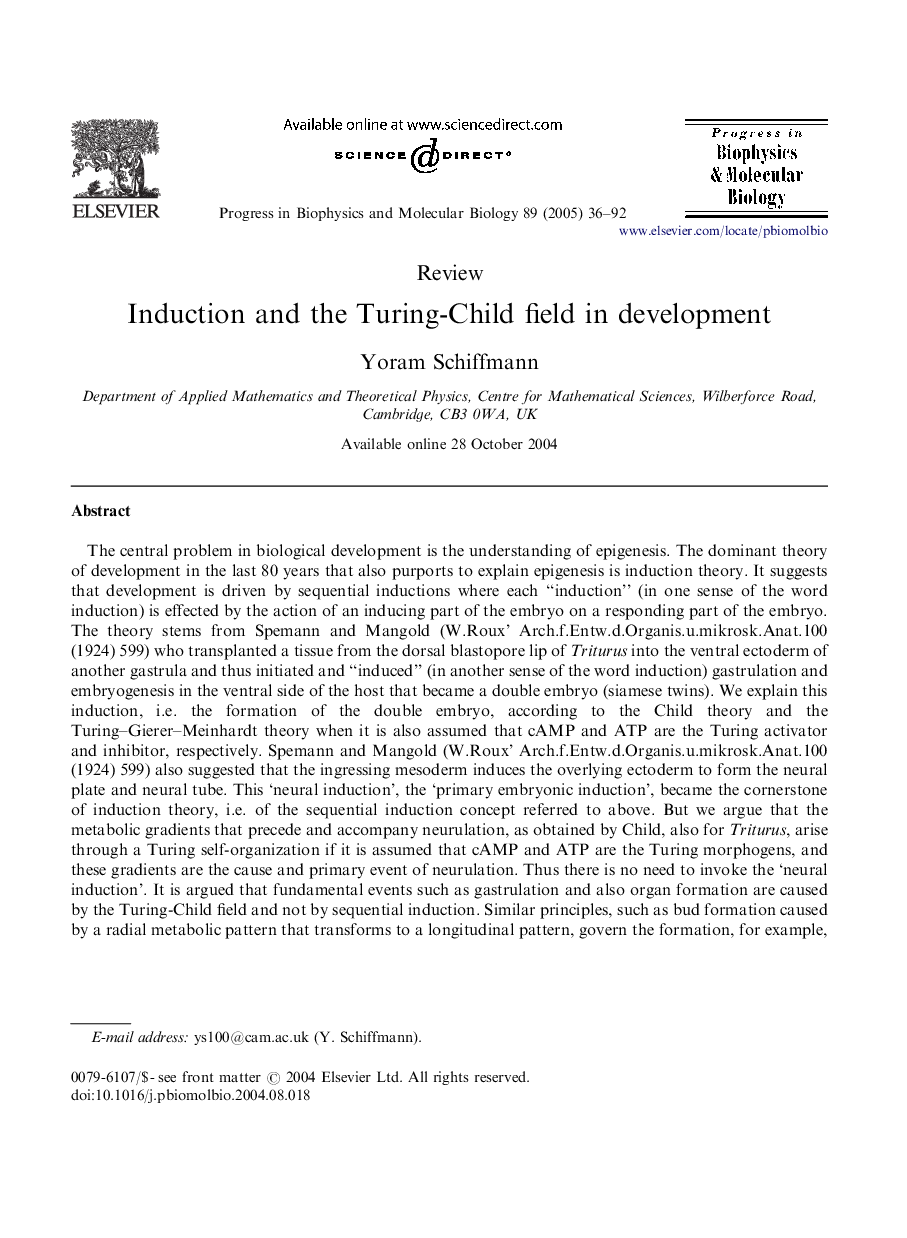| کد مقاله | کد نشریه | سال انتشار | مقاله انگلیسی | نسخه تمام متن |
|---|---|---|---|---|
| 10883633 | 1078500 | 2005 | 57 صفحه PDF | دانلود رایگان |
عنوان انگلیسی مقاله ISI
Induction and the Turing-Child field in development
دانلود مقاله + سفارش ترجمه
دانلود مقاله ISI انگلیسی
رایگان برای ایرانیان
کلمات کلیدی
موضوعات مرتبط
علوم زیستی و بیوفناوری
بیوشیمی، ژنتیک و زیست شناسی مولکولی
بیوفیزیک
پیش نمایش صفحه اول مقاله

چکیده انگلیسی
The central problem in biological development is the understanding of epigenesis. The dominant theory of development in the last 80 years that also purports to explain epigenesis is induction theory. It suggests that development is driven by sequential inductions where each “induction” (in one sense of the word induction) is effected by the action of an inducing part of the embryo on a responding part of the embryo. The theory stems from Spemann and Mangold (W.Roux' Arch.f.Entw.d.Organis.u.mikrosk.Anat.100 (1924) 599) who transplanted a tissue from the dorsal blastopore lip of Triturus into the ventral ectoderm of another gastrula and thus initiated and “induced” (in another sense of the word induction) gastrulation and embryogenesis in the ventral side of the host that became a double embryo (siamese twins). We explain this induction, i.e. the formation of the double embryo, according to the Child theory and the Turing-Gierer-Meinhardt theory when it is also assumed that cAMP and ATP are the Turing activator and inhibitor, respectively. Spemann and Mangold (W.Roux' Arch.f.Entw.d.Organis.u.mikrosk.Anat.100 (1924) 599) also suggested that the ingressing mesoderm induces the overlying ectoderm to form the neural plate and neural tube. This 'neural induction', the 'primary embryonic induction', became the cornerstone of induction theory, i.e. of the sequential induction concept referred to above. But we argue that the metabolic gradients that precede and accompany neurulation, as obtained by Child, also for Triturus, arise through a Turing self-organization if it is assumed that cAMP and ATP are the Turing morphogens, and these gradients are the cause and primary event of neurulation. Thus there is no need to invoke the 'neural induction'. It is argued that fundamental events such as gastrulation and also organ formation are caused by the Turing-Child field and not by sequential induction. Similar principles, such as bud formation caused by a radial metabolic pattern that transforms to a longitudinal pattern, govern the formation, for example, of the mouth and the gut. The formation and localization of bottle cells is explained according to the Child-Turing field and modern biochemistry. The chemical metabolic pre-pattern precedes, and causes, morphogenesis and differentiation as envisaged by Turing. The Spemann and Mangold (W.Roux' Arch.f.Entw.d.Organis.u.mikrosk.Anat.100 (1924) 599) transplantation experiment when performed on a sea urchin duplicates not only the phenotype but also the metabolic (reduction) pattern. These experimental results, by Horstadius, predicted by Child, follow from the Turing-Gierer-Meinhardt theory if it is assumed that cAMP and ATP are the Turing morphogens. If the transplantation is performed not onto the whole sea urchin but onto only a part of it, that manifests only a part of the metabolic pattern, then from the part a phenotypic whole underlain by a normal and a whole metabolic pattern can be rescued. These experimental results of Horstadius follow from Turing theory if cAMP and ATP are the Turing morphogens. Understanding how to transform a part into a whole can be valuable in regenerative medicine. Unspecific induction of a secondary amphibian embryo is similar to the induction of posterior structures at the anterior pole of an insect, and the “double abdomen” (and Kalthoff's experimental results) of the midge Smittia resulting from UV irradiation of the anterior pole, can be explained by Meinhardt theory of unspecific induction if ATP is the Turing morphogen. When not working on regeneration, Child investigated intact living organisms and his observation method was not disruptive to normal development, whereas workers in induction theory work with pieces and in general disrupt normal development. We conclude that the Turing-Child field causes all development and explains epigenesis. Sequential induction does not explain epigenesis and does not exist in normal development. But induction in the sense of a transplantation leading to double embryo or rescuing a whole phenotype from a part is of interest.
ناشر
Database: Elsevier - ScienceDirect (ساینس دایرکت)
Journal: Progress in Biophysics and Molecular Biology - Volume 89, Issue 1, September 2005, Pages 36-92
Journal: Progress in Biophysics and Molecular Biology - Volume 89, Issue 1, September 2005, Pages 36-92
نویسندگان
Yoram Schiffmann,